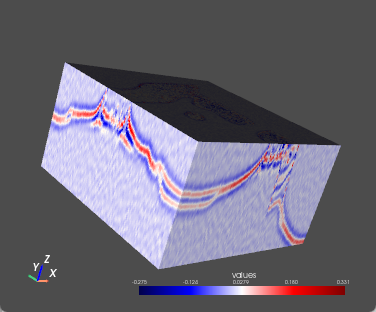
地震褶积方法制作合成地震记录c++
地震褶积方法制作合成地震记录包括,(1)读取相模型,设置每种相的密度和速度,(2)计算反射系数,添加噪音,(3)设置子波,(4)进行褶积计算。
地震褶积方法制作合成地震记录
包括,(1)读取相模型,设置每种相的密度和速度,(2)计算反射系数,添加噪音,(3)设置子波,(4)进行褶积计算。具体的代码如下
void syntheticSeis(const string& faciesFileName, const string&synseisFileName,
vector<tuple<int, double, double>>faciesDenVelocity,
double dt, double fm, int convLength)
{
const double PI = 4 * (4 * atan(1.0f / 5) - atan(1.0f / 239));
IModel3D<int> facies;
facies.loadNumpy(faciesFileName);
int ni = facies.getNi();
int nj = facies.getNj();
int nk = facies.getNk();
auto faciesList = facies.getValueVec();
for (auto item : faciesList) {
bool find = false;
for (auto fv : faciesDenVelocity) {
if (get<0>(fv) == item) {
find = true;
break;
}
}
if (find == false) {
std::cout << "fail to find facies " << item <<
" in facies_velocity_set" << std::endl;
return;
}
}
// define the velocity of each facies
auto impedance = IModel3D<float>(nj,ni,nk,"veclocity");
const int* faciesPtr = facies.grid().data();
float* impPtr = impedance.grid().data();
random_device dev;
default_random_engine rnd(dev());
uniform_real_distribution<double> u(0.95, 1);
for (int i = 0; i < ni * nj * nk; i++) {
int faciesV = faciesPtr[i];
for (const auto& item : faciesDenVelocity) {
if (get<0>(item) == faciesV) {
//impPtr[i] = get<1>(item)* get<2>(item);
impPtr[i] = get<1>(item) * get<2>(item) * u(rnd); //with noise
break;
}
}
}
// define the reflection coefficient
auto refCoef = IModel3D<float>(nj, ni, nk, "reflectionCoefficient");
for (int j = 0; j < nj; j++) {
for (int i = 0; i < ni; i++) {
refCoef.setValue(j, i, nk - 1, 0);
for (int k = nk - 2; k >= 0; k--) {
float imp1 = impedance.getValue(j, i, k + 1);
float imp2 = impedance.getValue(j, i, k);
float coef = (imp2 - imp1) / (imp2 + imp1);
refCoef.setValue(j, i, k, coef);
}
}
}
float vMin = FLT_MAX, vMax = -FLT_MAX;
refCoef.getMinMax(vMin, vMax);
std::cout << "refcoef vmin= " << vMin << " vmax= " << vMax << std::endl;
// calculate syntheic seismic
int n = convLength;
auto rickerWave = [=](int kk)->float {
return (1 - 2 * pow(PI * fm * dt*kk, 2)) * exp(-pow(PI * fm * dt*kk, 2));
};
// define the synthetic seismic trace
auto synSeis = IModel3D<float>(nj, ni, nk, "syntheticSeis");
for (int j = 0; j < nj; j++) {
for (int i = 0; i < ni; i++) {
for (int k = nk - 1; k >= 0; k--) {
// seismic convolution
double trace = 0.0;
for (int t = -int(n / 2); t<int(n / 2); t++) {
if (t + k < 0 || t + k >= nk)
continue;
else
{
double riker = rickerWave(t);
double coef = refCoef.getValue(j, i, k + t);
double value = riker * coef;
trace += value;
}
}
synSeis.setValue(j, i, k, trace);
}
}
}
synSeis.saveNumpy(synseisFileName);
vMin = FLT_MAX;
vMax = -FLT_MAX;
synSeis.getMinMax(vMin, vMax);
std::cout <<"create syntheitc seismic"<<synseisFileName<< " synseis vmin= " << vMin << " vmax= " << vMax << std::endl;
}
读取的参数文件
参数文件
#option data for create synthetic seismic trace
ricker_fm 25
ricker_dt 0.002
ricker_conv_length 40
#define density velocity of each facies
max_facies_num 12
facies_den_velocity_0 0 0.1 3000
facies_den_velocity_1 1 0.1 3200
facies_den_velocity_2 2 0.1 3500
facies_den_velocity_3 3 0.1 3200
facies_den_velocity_4 4 0.1 3500
facies_den_velocity_5 5 0.1 3200
facies_den_velocity_6 6 0.1 3500
facies_den_velocity_7 7 0.1 3200
facies_den_velocity_8 8 0.1 3500
facies_den_velocity_9 9 0.1 3000
facies_den_velocity_10 95 0.1 3200
facies_den_velocity_11 100 0.1 3200
files_contians_npy3dfile_at_each_line npy3dfiles.txt

更多推荐
 已为社区贡献2条内容
已为社区贡献2条内容


 华为云 x DeepSeek:AI驱动云上应用创新
华为云 x DeepSeek:AI驱动云上应用创新


 DTT年度收官盛典:华为开发者空间大咖汇,共探云端开发创新
DTT年度收官盛典:华为开发者空间大咖汇,共探云端开发创新


 华为云数字人,助力行业数字化业务创新
华为云数字人,助力行业数字化业务创新


 企业数据治理一站式解决方案及应用实践
企业数据治理一站式解决方案及应用实践


 轻松构建AIoT智能场景应用
轻松构建AIoT智能场景应用








 免费领云主机
免费领云主机




所有评论(0)